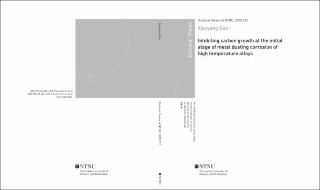| dc.contributor.advisor | Venvik, Hilde Johnsen | |
| dc.contributor.advisor | Chen, De | |
| dc.contributor.advisor | Walmsley, Charles | |
| dc.contributor.author | Guo, Xiaoyang | |
| dc.date.accessioned | 2020-08-27T11:46:38Z | |
| dc.date.available | 2020-08-27T11:46:38Z | |
| dc.date.issued | 2020 | |
| dc.identifier.isbn | 978-82-326-4773-6 | |
| dc.identifier.issn | 1503-8181 | |
| dc.identifier.uri | https://hdl.handle.net/11250/2675391 | |
| dc.description.abstract | Metal dusting corrosion is a high temperature degradation phenomenon affecting Fe-, Ni- and Co- based alloys when exposed to strongly carburizing gases (carbon activity ac > 1) at elevated temperatures (> 400˚C). The alloy disintegrates into a powdery mixture of metallic, carbidic, and carbonaceous dusts.
In order to capture the initial carbon formation on the Ni-based high temperature alloy samples (Inconel 601), systematically pretreated alloy coupons were subjected to metal dusting conditions as a function of time, composition, and pressure at 750˚C. The carbon deposition on the alloy coupon is clearly a function of the gas composition during exposure, less carbon is formed under 10% CO in Ar with infinite carbon activity than under synthesis gas with finite low carbon activity, which points to the impact of the reaction mechanism and kinetics. The characterization indicates that the metal dusting corrosion rate is lowered when Cr2O3 rather than (Ni, Fe, Cr)3O4 spinel is the major phase of the oxide scale formed on the alloy coupons. Fine-grain structure on the alloy surface is also found beneficial to resistance the metal dusting corrosion.
Formation of carbon on the Incoloy 800 alloy surface of pre-oxidized samples was investigated by exposure to reducing, highly carburizing atmosphere (CO in Ar) at 20 bar and varying temperature (550-750 ˚C). The amount and the type of carbon materials are found to vary strongly with the exposure temperature and the interaction with the metallic matrix. At the highest temperature i.e. 750 ˚C, also the alloy coupons undergo considerable change in the elemental distribution as a function of depth.
Finally, efforts have been devoted to inhibiting of metal dusting corrosion on Incoloy 800. Results show that Incoloy 800 samples treated by combined near surface severe plastic deformation (NS-SPD) and thermochemical treatment at elevated temperature exhibit no carbon formation, compared with the region not treated by NS-SPD on the sample. The good corrosion resistance performance is a result of the mechanical process produced an ultrafine-grained structure with a higher fraction of grain boundaries together with other microstructure defects near the surface. These microstructure defects increase the effective diffusion coefficient for Cr in the alloy, promoting the formation of a thin, protective Cr-rich oxide scale during the thermal treatment, which prevents contact between the carburizing atmosphere and the Ni and Fe contained in the bulk of alloy. The results imply that the metal dusting resistance performance of Incoloy 800 in industrial applications can be improved significantly by NS-SPD followed by thermochemical oxidative treatment. | en_US |
| dc.language.iso | eng | en_US |
| dc.publisher | NTNU | en_US |
| dc.relation.ispartofseries | Doctoral theses at NTNU;2020:212 | |
| dc.relation.haspart | Papers 1:
Xiaoyang Guo, Estelle Vanhaecke, Per Erik Vullum, Jianyu Ma, P. V. D. S. Gunawardana,
John C. Walmsley, De Chen, Hilde J. Venvik.
Effects of metal dusting relevant exposures of alloy 601 surfaces on carbon formation and oxide development
https://doi.org/10.1016/j.cattod.2020.04.029
Attribution 4.0 International (CC BY 4.0) | en_US |
| dc.relation.haspart | Paper 2: Guo, Xiaoyang; Gunawardana, Daham; Chen, De; Vanhaecke, Estelle Marie M.; Venvik, Hilde Johnsen; Walmsley, John. Investigation of metal dusting corrosion process over UNS N08800 alloy. NACE International 2017 | en_US |
| dc.relation.haspart | Paper 3: Xiaoyang Guo, Estelle Vanhaecke, Per Erik Vullum, John C. Walmsley, De Chen, Hilde J. Venvik. Inhibition of Metal Dusting corrosion on Fe-based alloy by combined near surface severe plastic deformation and thermal treatment | en_US |
| dc.relation.haspart | Paper 4: Hilde J. Venvik, Xiaoyang Guo. Method for reducing metal-dusting corrosion. Patent application, Intellectual Property Office, United Kingdom, application number:1913256.2 | en_US |
| dc.title | Inhibiting carbon growth at the initial stage of metal dusting corrosion of high temperature alloys | en_US |
| dc.type | Doctoral thesis | en_US |
| dc.subject.nsi | VDP::Technology: 500::Chemical engineering: 560 | en_US |

